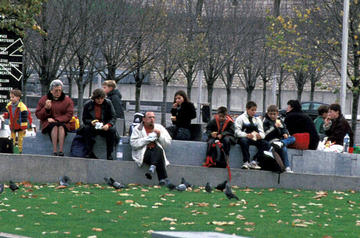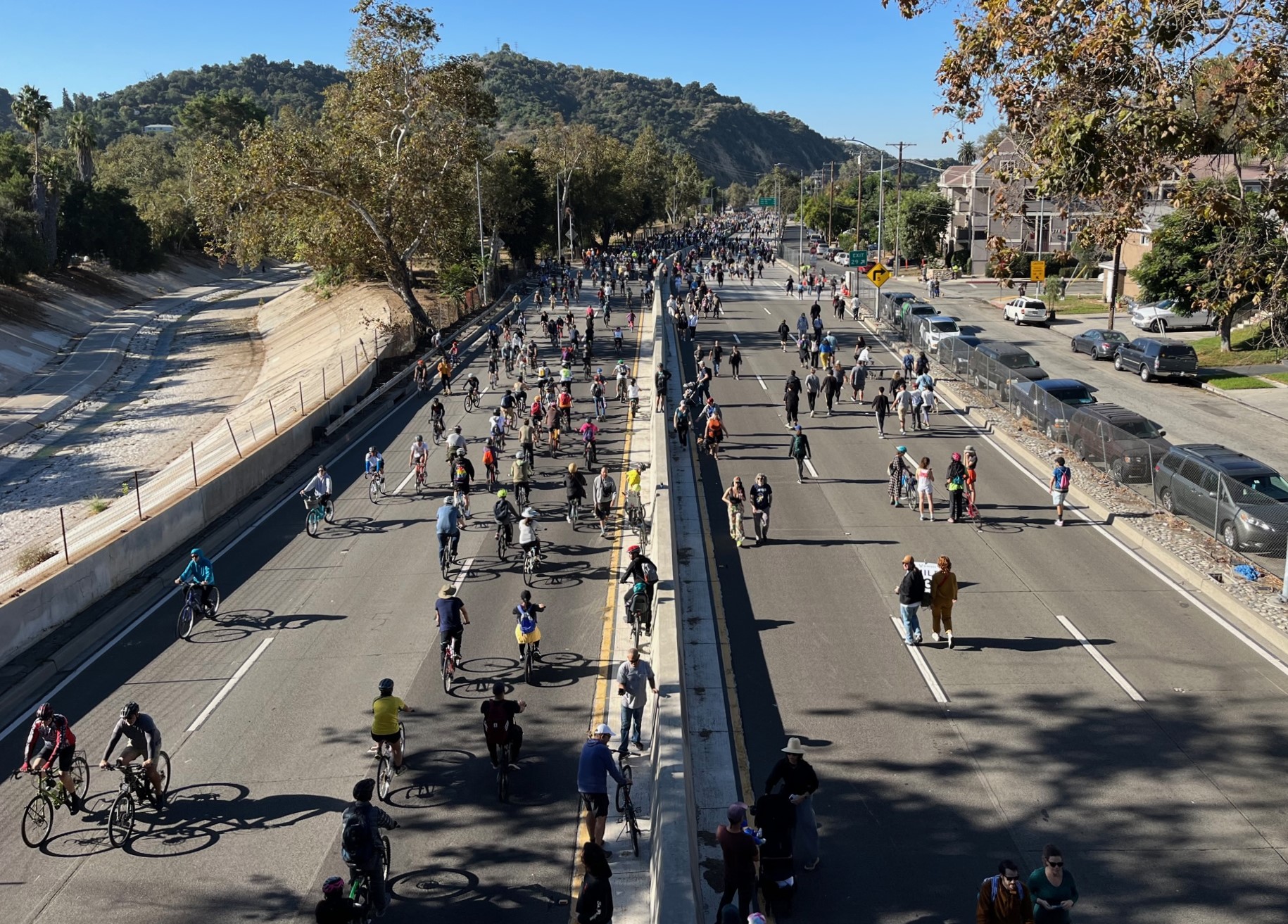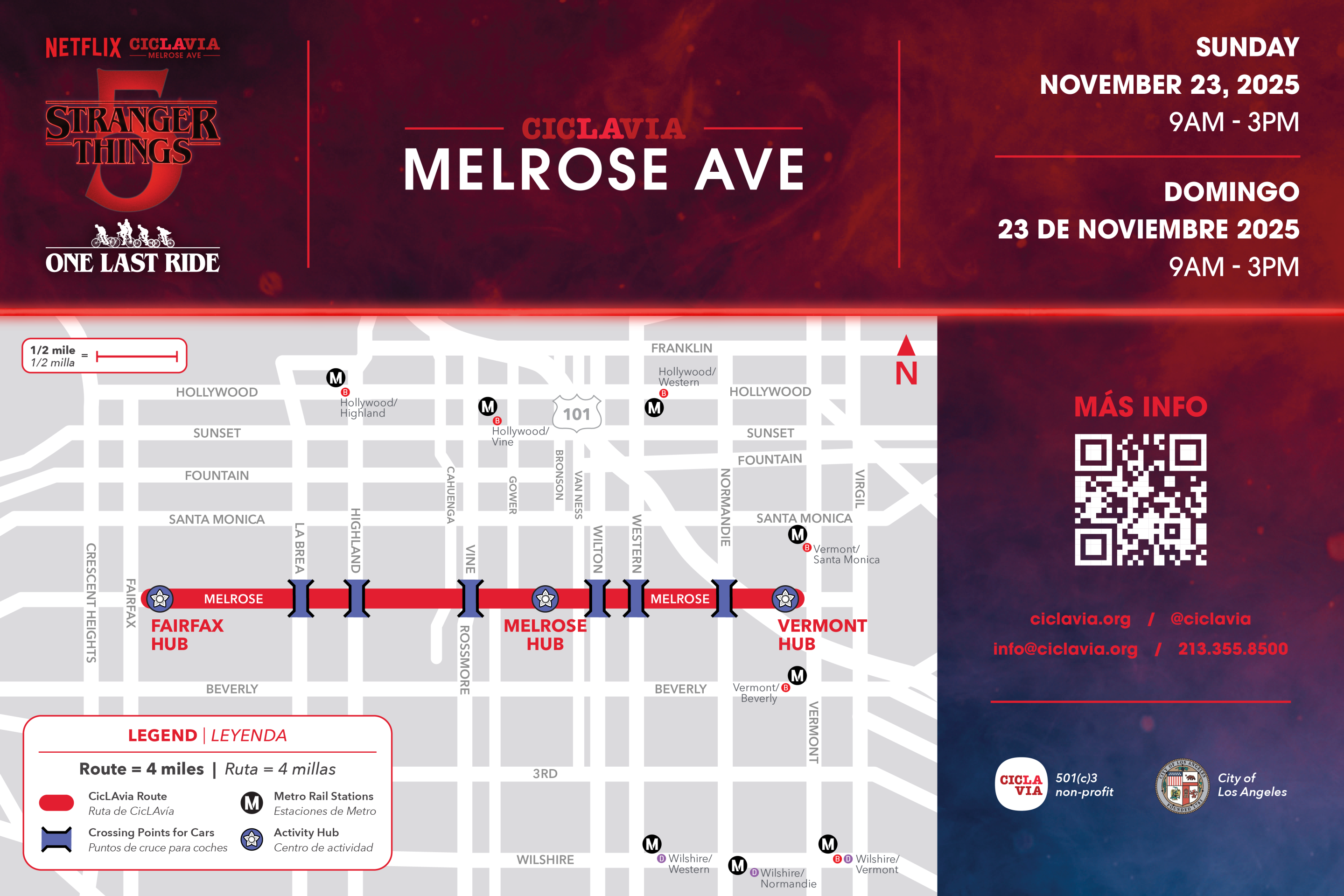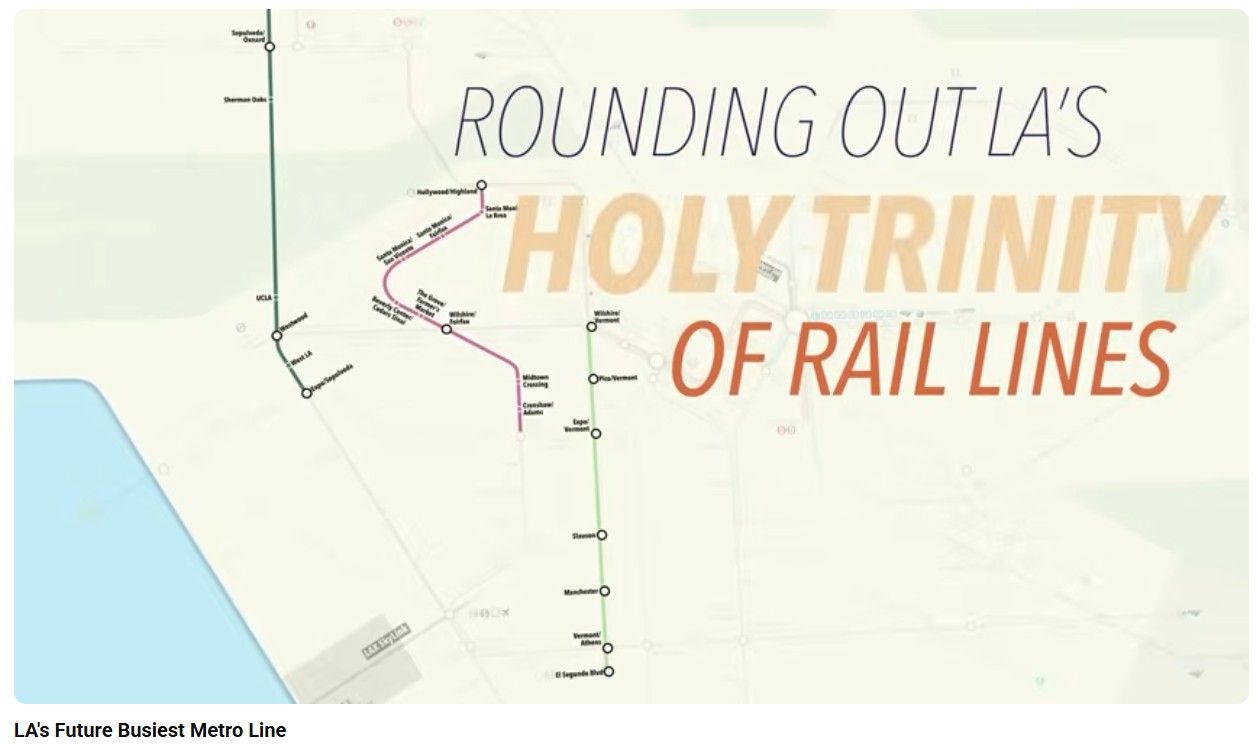
I sometimes dream about a different Los Angeles; not the sprawling congested city, but an L.A. that is a series of walkable villages, like for example Santa Monica. They would be full of life and economic vitality, with corner stores, markets, coffee shops, plazas and parks. And they would all be connected by rail lines; streetcars that can whisk us away to anywhere we want to be, with no delays, traffic jams, etc. As we look out the streetcar’s window on our way to the next village, we’d notice the city changing... The higher central city with shops and apartment buildings becomes a more quiet residential area, with smaller apartment blocks, then row-houses, then duplexes, then single family houses, and then the streetcar goes through a park, with gardens and fields!
On the way back, the reverse happens. Along the way, we have seen people walking, chatting in the streets, kids playing in the park, people gardening, bicycling – and even some people driving.
This is not the way many perceive L.A. But it is probably not too different an experience one might have had in L.A. a couple generations ago.
Christopher Hawthorne speaks about L.A. in a useful metaphor: as a First and a Second Los Angeles, and he now sees a third Los Angeles emerging. The First Los Angeles stretches roughly from the city’s first population boom in the 1880s through 1940. That L.A. was what I described above. L.A. rapidly expanded at an exponential pace along a major transit network, and innovative civic architecture was built along the way.
L.A. once had the largest streetcar transit network in the U.S. It was, at one point, all owned by Henry Huntington. Huntington used streetcars to shuttle people to his various real estate developments. Yes, before we built the suburban sprawl we know today, L.A. built up streetcar suburbs: denser nodes around the stations of our streetcar network. These are the places we still love today: Santa Monica, Long Beach, Redondo Beach, Glendale, Burbank etc.
The weather here is always perfect, and in this unique climate we developed both walkable communities, and innovative residential projects, for example the great garden courts of Wyvernwood, Village Green and Lincoln Place.
But it was the Second Los Angeles, in Hawthorn’s lingo, covering the period from 1940 to the turn of the millennium, which is giving us such an urban design hangover today.
The intention was good. We mass produced houses that afforded unprecedented economic access to home ownership for the middle class. In the process, we turned a complete transportation system over to the automobile, and we eventually generated never before seen environmental problems and sprawl.
In doing this we redefined the meaning of urban design.
There are many definitions for urban design. One in particular says that “urban design creates the outdoor living rooms for our public lives.”
The suburbia we built after WWII was not meant to support our public lives.
Suburbia is intended as a privatized, car-dominated landscape. Open space was to be privatized, divided up to each house, one at a time into the backyard. Of course, there were political motives then, too. This was a time when communism was seen as the great threat to society, and a group of people gathering in the streets could easily be mistaken as the beginning of a communist conspiracy.
In suburbia, the streets were no longer spaces for us to spend time outside our cars. The street’s new and exclusive purpose was to get from private place to private place, in a vehicle. This was the time when crossing a street as a pedestrian, thus interfering with traffic, was first deemed an offense. Jaywalking did not exist until then.
A website that describes our malaise with our urban spaces in the car age is entitled “Places where I don't want to sit.” That almost says it all. Think about the public spaces we live in, our streets, our parking lots, our little parks that are created as token open space in the leftover land outside our buildings; they are all spaces where it’s not pleasant to sit.
However, amidst of all of this, a Third Los Angeles is now beginning to emerge.
At a quick glance, there is a lot of good news in recent years:
- smog has greatly diminished
- Los Angeles is heavily investing in mass transit
- bike-share is being rolled out
- we just passed a new Mobility Plan that is finally drawing a battle line in the sand between humans and cars
Yes, there is good news – we are changing. But we are not nearly changing fast enough to keep up with the size of our challenges. These challenges include:
- an enormous housing shortage, both in terms of absolute numbers and in affordability
- regardless of all our efforts we are still predominantly a car city
- we have little money in our budget to fix our infrastructure, and
- we are a city with almost no park space per capita, when compared to other cities of similar scale.
But our by far biggest challenge is how wastefully we use land. This includes the following.
How much land do we use for parking?
In Greater Los Angeles, there are 3.5 parking spaces for every one of the 18 million inhabitants. These occupy a land area equal to ten times the entire city of Long Beach and the entire city of Santa Monica, combined.
How much land are we giving up for the automobiles, in total?
According to our planning guru Donald Shoup, L.A. uses more than 60 percent of its land area for automobile transportation. That is two-thirds of our city, dedicated to never earning a cent in revenue for the city. But this area requires a lot of monetary input to keep in some functional shape. Manhattan, a city with extremely high intensity only uses 35 percent of its land for cars. According to A Pattern Language, the ideal amount of land dedicated to transportation in a balanced, multi-modal city is approximately 19-20 percent.
So, in an ideal city, four parts of land earn revenue to support the last one part of the city that needs maintenance dollars. For us here in L.A. this ratio is 2:3 against us. This is why L.A. is broke, and destined to be, forever, unless we build it differently!
How much money do we spend on cars?
According to the American Automobile Association, it costs, on average, approximately $8,500 per year to own and operate a car. Of that amount, more than $7,000 per year goes out of the local economy, much of it to international oil companies and car manufacturers.
In 2009 L.A. County had 6.7 million registered vehicles. 6.7 million times $7,000 not spent locally equals approximately $47 billion. What L.A. would look like with $ 47 billion per year injected into the local economy?
The more people we are getting out of cars, the better are our chances to grow our local economy. Of course, this is no secret and many cities in the world are aggressively working on eliminating cars from their city. There are seven European cities who committed to the goal of eliminating cars from the urban core by 2020.
Paris just experienced its first car free day, with great success.
There is even a neighborhood in Nashville TN that will try out a car free week.
This movement is also very clear to many car companies who are desperately working to reinvent themselves as urban mobility providers. Many cities are beginning to claw back the space once freely given over to cars. Road diets are more and more common and are only the beginning. Cities are taking back car infrastructure and are converting it back into usable space - for humans. In San Francisco, when the Embarcadero Freeway collapsed in the 1972 Earthquake, the city did not rebuild it and now boasts instead a vibrant, affluent waterfront. The city of Seoul tore out a two level freeway through the middle of the city, and is enjoying instead today a world renowned linear park. There are many more examples worldwide to the same effect.
The end game is clear.
At this year’s world economic forum, Al Gore and former president of Mexico Felipe Calderon asked for a fund in the size of $90 trillion to redesign all major cities on earth without cars - in order to maintain the earth as a comfortable place to live.
Why does this vision seem so much further away from immediate reality in the U.S., than in so many other places?
We just have so much “car-city” here in L.A., and very few people locally can really visualize life without it. And the “car-city” and transit are a square peg and a round hole. With transit, we are inserting an alien DNA into our predominantly car based infrastructure, and we are experiencing tissue rejection.
In order to make real progress, we simply have to accept that we will need to have two different types of city in the same physical area. One of those two types is the walkable transit city. It will become more important and grow in the coming years. But the other one, the car-based one, is still valid in many areas and will remain so for many years to come. What we need to do is find ways to relate one city to the other. And treat each one type with the respect it deserves.
For those areas that will remain car-based, we should do what we can to make them function as best possible – including building more roads, if needed. But around our transit nodes, we need to create completely different rules. If we did this, we will see amazing changes happen all by themselves.
There is stunning success with downtown L.A. It was originally created around streetcars and walkability. In the 60s, we burdened it with car based planning rules and just about killed it dead. A few years ago, our city council relieved the downtown area of those rules, mostly around parking – and the downtown took a deep breath, and has been roaring back to life ever since.
With a broad view towards rethinking Los Angeles as a better city, we need to rediscover what urban design is actually intended to accomplish. We talk about road diets, pedestrian environments, mode share, and mixed use… but this is really just “planning speak.” We should also state that urban design is supposed to create public places where we want to sit, walk, promenade, run into each other, play and enjoy our public lives.
It helps to remember a historically rigorous distinction between urban and not-urban buildings. In other words, different ways how buildings on different lots can relate to each other. In European cities there is the concept of “connected building style.” Buildings usually are built right up to the property line, there are no side yards, and buildings can connect with each other into larger forms of street walls, enclosed courtyards, etc. There is also the “open building style”, where freestanding buildings set back from the property lines to allow for some buffer space from each other. However, that building method is only meant for the countryside, and at best a very small village.
Then there are suburban areas, where today most people live. Suburbanites like to pretend that they are not really in a city, sub-urban planning almost exclusively favors the open building style. But our suburbs are huge and rival in size many cities worldwide. It does not make sense to build an area as vast as Los Angeles with buildings meant for a small village. But this is what we have been doing.
Locally, only very few cities, usually the ones that started before the automobile, allow for the closed building method. And yet this is the very method we need to use if we are to ever again define quality urban space.
Urban space creates the positive form we are trying to generate in order to create a sense of community. The role of the individual buildings are that they need to surround and help define that urban space with a nice façade, a nice street wall.
Good streets and plazas do not have open buildings standing on its perimeter. In positive urban space, the individual character of the building is subordinated to the larger purpose of creating urban places where we might want to sit.
In order to accomplish this, we need to bring back old building types we have all but eliminated from our design vocabulary. Fee simple row houses are the single family houses of the transit city; but there are also duplexes, multi apartment villas, dingbats, smaller individual owned apartment buildings that form a block with protected open space in the middle. Much of those building have existed in the U.S. as well as elsewhere in the world, before we just eliminated it all – mostly because of the cars.
In our new transit oriented communities, we need to define if and how to allow cars. Maybe we only allow parking below grade, maybe we only allow parking on streets in short term parking. Maybe we need to think about providing parking as a public utility at the perimeter of these new streetcar suburbs, and make many streets inside the radius into pedestrian zones. Maybe we only allow taxis, limos, Uber and Lyft to drive. And maybe we configure our streets into a pedestrian and bicycle district around the transit station.
Whatever it may be, we need to elevate the creation of the new transit oriented communities to our common emergency. If we want L.A. to be more prosperous, focus on community and quality of life, and if we want to recapture our ability to move around freely again, this is the first step.
The Third L.A. might in the end look very similar to the First L.A. described above.
History has a funny way to return to places where we have already been, but not exactly in the same plane.
The real problem is how to do this locally. We really need to drop the pretension that we know what we are doing. It is not our fault. We have not had much opportunity, or been allowed to really think about planning for pedestrians or bikes, or kids playing in parks. We were forced to design and plan and arrange our lives for and around the automobile for almost 80 years. With so little local knowledge about urban design and walkable city planning left in LA, we should focus on jump-starting a creative rediscovery process that will catch us up with best practices elsewhere.
A method that could work:
As a first step, the city should stop pretending that we have all the answers how to change the city and instead declare itself an urban design lab for creative community re-envisaging and redevelopment around new transit.
We would then start generating ideas what these new communities around transit should look like. Rather than rely on the same processes that have not generated meaningful change to date, why don’t we instead ask communities to help us co-create? In this vast city, with such rich cultural background, we will find many communities with willing participants; people who still value their public lives in urban spaces.
We should also look to employ competitions for ideas, open to people from all walks of life, experts and amateurs alike, from all over the world. We would throw away all the rules we think we have to live by and engage in a thought experiment, where we reinvent how we could live in L.A., near a transit stop.
A consensus can emerge that has broad based support in the community, an essential prerequisite for implementing broad changes. The winning ideas can then be captured in an experimental specific plan for that transit oriented community, replacing the car-centric rules that are guiding us now.
This can all be paid for through a process of public private partnerships (PPP). We, the public, own land near our transit stops. Remember how much land we are using for our car transportation? Through transit oriented planning we can recapture a good amount of land and return it to purposes other than car traffic. That is then the land that could be developed by private parties, if that land was made available to those parties under conditions “too good to refuse.” We, the public, would still get revenue from these leases, and future tax receipts, of course. This is revenue we currently cannot capture, and more than enough to finance the administrative cost of this enterprise.
In order to make sure that we all like the actual building projects that are happening on our land, we could make those projects subject to design competitions also. The developers would only be able to build those projects that were competition winners.
This idea loosely follows a format from a German urban redevelopment model that is happens every couple of years in Germany and elsewhere in Europe, and achieves monumental urban changes in a very short time frame, typically 10 years.
The model is called IBA – “Internationale Bau Ausstellung”, which translates into International Building Exhibit. Through the reliance on PPPs the project will be self-funding from the moment private development interest and public properties are connected.
We are rightfully proud of our city’s status as a design mecca. And we have a lot of great buildings to show for here. Just because there are a lot of great buildings, does not automatically result in a great city!
This is how I became inspired to name this new effort DesignCityLA 2.0. The name DesignCity is reminiscent of our past glory as creative capital, and the number 2.0 signals the second iteration of our proud tradition, where we rediscover the urban space as our public living rooms, again.
The new L.A. does not need to mean an either-or future. We will still have cars, and plenty of single family neighborhoods. But we also can create something new, neighborhood types similar to the ones we once had and still love today.
Large scale urban change is happening all over the world. The role of the automobile as driver of our future is very much in question.
We, in L.A., should embrace this new future. The brand “L.A.” is strong. Let’s become the new design city, for ourselves; and lead the many others around the world who are still looking up to us.
Let’s again build places where we want to sit!
Gerhard W. Mayer practices architecture/urban design in Los Angeles. Born in Vienna, he has worked all over the globe for the past 30 years. Gerhard is a local activist for transformation towards walkable, transit connected communities. Gerhard also served as chair of the LA-AIA’s Urban Design Committee. This article was adapted from a talk Mayer gave at the New Urbanism Film Festival.






